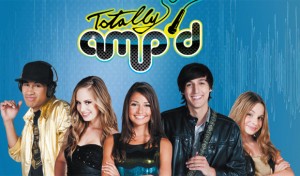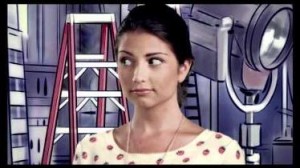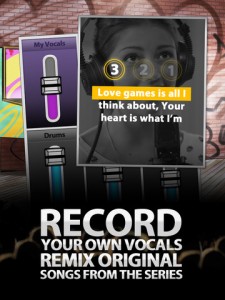
Transmedia case study-Guidestones
By Sheri Candler
In the continuation of our look at recent cross platform/transmedia projects, this case study will be particularly relevant to those working with low budgets and ambitious plans. Writer/director Jay Ferguson’s initial inspiration for Guidestones came from his late father’s fascination with serialized shorts. Growing up in the thirties and forties, Ferguson’s father went to the cinema and was ‘hooked’ on serialized shorts where bad guys tie distressed maidens to the train tracks and such. Ferguson thought that the internet would be an ideal place to try to recreate that experience for this century.
Again, thanks to Storycode.org for providing the video presentation (found at the bottom of this post) from which these notes were culled.
Jay Ferguson, writer/director, 3 o’clock TV
Synopsis
Two journalism students, investigating an unsolved murder, uncover a global conspiracy centered around the mystery of The Georgia GUIDESTONES, an enigmatic monument nestled in a farmer’s field in rural Georgia and inscribed with directions for rebuilding civilization after the apocalypse. The story is based on a real monument and on the real account of a Toronto woman’s experiences.
GUIDESTONES uses elements of transmedia and ARG storytelling to take viewers on a thrilling chase that crosses two continents and three countries in search of the truth. The project uses a hybrid mix of traditional narrative and formal and non-formal documentary styles. Shot vérité style in Canada, the USA and India, the series moves seamlessly between the real world and the fictional account of how a young woman named Sandy stumbled upon a murder mystery.
Three minute episodes, 50 in total so far, with audience participation elements.
Intent:
Ferguson wanted to tell stories by professional storytellers that would guide the audience an online and offline experience. He observed that, though audiences wanted to participate in the story somehow, no one wants to pay for online content. Also, how to keep audiences coming back? Too many webseries start out with the first few episodes being ok then die with audience numbers. Ferguson and his team have endeavored to keep up a fast paced, engaging story that pushes the audience to continue the journey.
Funding:
A mix of self funded, Canadian Independent Production Fund, some matching grants from the Ontario Media Development Council , sponsorship from Samsung, Carbon Clothing, Major League Baseball/Toronto Bluejays, Pizza Pizza (Canadian Domino’s). The online platforms (Hulu, Youtube) did not put in any money. The total budget is around $300,000 CAD. Estimate to reproduce at market value would be $1 million.
Revenue streams:
Product integration, merchandise/music/ringtones, rev share from Hulu. Recently launched on iTunes and considering a DVD to sell.
Audience demographic:
While there were certain demographics in mind, the production recognized that different audiences will want to interact with the series, so different ways to view the project were developed. In the Push version, one can sign up for the show and have the episodes delivered via e-mail to experience in ‘real time’ as the characters are exploring the mystery. The Linear version is for those who want to be more passive and treat it like a traditional serialized show.
Background of the team:
Jay Ferguson is an award-winning filmmaker who has contributed as a writer, director, producer and cinematographer to over 15 feature films. His work with institutions such as The National Film Board of Canada has garnered him several awards, including the top cinematography award at the Atlantic Film Festival (Animals, 2005) and from the Canadian Society of Cinematographers (Inside Time, 2008). He was nominated for a Gemini Award in 2005.
Jonas Diamond is the CEO of iThentic, joining the team in the fall of 2008. Jonas is producer of the award-winning animated series Odd Job Jack (52×30). The series received a Gemini, CFTPA Indie, Banff Rockie and Canada New Media Award for Best Cross Platform Project. Additional Accolades for Odd Job Jack include a nomination for Best Interactive Program (2006) and Best Animated Show (2005) at the Banff Rockie Awards, second prize for Best Interactive Design (2006) at Vidfest, Best Convergent Project by the Banff Institute as well as multiple Gemini and Canadian Comedy Award nominations. Jonasʼ producer credits includes Odd Job Jack, Hotbox and Bigfoot for The Comedy Network / CTV, Pillars of Freedom for TVO, Turbo Dogs for CBC / NBC, The Dating Guy, skatoony, Sons of Butcher and the upcoming Geofreakz MORPG for Teletoon, The World of Bruce McCall, and the interactive storyteller Legends of Me as well as many other projects for various platforms.
Development phase:
It took 3 years from conception to launch.
Thinking through each platform:
50 webisodes were shot and edited for use as video links, the main storyline.
50 different websites were needed to house the clues for each webisode.
Content was hidden online for viewers to research the clues given during the webisodes.
One of the really hard things was creating 50 story arcs. Each episode is on average 3 minutes long and it is difficult to find an interesting opening, build the story and then a climax to lead into the next episode in such a short space of time. For feature films, you may only have to do one or two of those, but 50 is a lot. The interactivity was very difficult to make happen…very time consuming.
Production workflow:
The production used a very small crew and shot with a Canon 7d digital SLR in order to have flexibility and adaptability when on location. It allowed them to get into places that you regularly would not be allowed to shoot. In India, there were some places that do not regularly allow filming, but they were able to shoot some scenes in a few minutes and not bother anybody.
8 months in production, with 8-10 hour days
Location shooting: 3-4 weeks Toronto, 1 week in Georgia, 1 week in India
Post production meant bringing together all the elements of web and film. Before locking an episode, online properties needed to be created and sites linked to other sites so that the minute it was live, everything was in place for the viewer to experience.
Digital team included:
A graphic designer
Website builder
1 person to buy and manage urls
people to develop online presences on Linkedin and MySpace
2 editors full time
2-3 editors part time
a media manager
effects supervisor
effects editor
Brad Sears who designed the Push system and email system.
Deployment strategy
They launched the “push” system in February 2012. The viewers sign up via email address on their website to follow the episodes. Links are emailed to them with the episodes. Emails are timed to coincide with the happenings of the characters (if something happens at 9am, the email is sent at 9am). It takes the viewer a month to experience the whole thing and it is evergreen which means anyone can start it whenever they like. There is no “starting” and “ending” period.
After launch, the team received a lot of feedback from viewers. High schoolers in particular were impressed that they could Google things they had seen in the show, and something was actually there online. Also found that high schoolers do NOT use email like adults do. They communicate more via Facebook. Production team then modified the “push” system to run on Facebook.
For older people, they complained of too much email (50 episodes plus supplemental info). Some complained not enough episodes being released fast enough. They modified their release pattern/experience. Now viewers can choose to experience via Facebook, email or in a linear version where they just watch the episodes on their own time instead of following along with the characters. The linear version is on Hulu and on iTunes.
Building the Audience
Ferguson concedes that not enough money has been spent on publicity. Largely marketing has been a mix of public speaking, interviews in publications on the process, word of mouth by the viewers with a tshirt promotion for those who bring in 5 viewers. Brand sponsors are doing some of the promotion, particularly Pizza Pizza who play a 30 second ad for Guidestones in each of their stores across Canada. They are hoping that being on Hulu will help garner a larger audience for the project due to its large amount of traffic. Both Pizza Pizza and Samsung have done prize promotions on their Facebook pages for the show.
Achievements
-The clue finding is actually going very well. People really love it and get excited looking for the content. The first season really taught lessons in how to create on-line interactivity…now the team wants to take it further and have many ideas on how to get even more interactive.
-Through connections gain on other projects, the team was able to broker an agreement with Hulu to host the series and have an advertising revenue share.
-The series is now selling on iTunes in the TV show section. The whole season download is priced at $9.99 or one can buy them per episode for $1.99.
-The acting is critical to the storytelling and the believability of any story. Supinder Wraich (Sandy) and Dan Fox (Trevor) have a real honesty that is hard to find in actors. Both can act really well directly to camera because they are able to empathize with the characters and that brings this very genuine quality that audiences respond to, it is very hard to fake that emotion without the audience feeling it. Ferguson’s tip in casting is that when watching the actor closely, don’t worry too much about the words or the actor’s look necessarily, look into the eyes, see if there is a true belief in there. If they believe it, so will the audience.
Challenges
-To the conventional viewer, the non-totally immersed viewer, the Push system adds up if they are not able to get to the emails often enough and that became frustrating for some people who didn’t realize there was a more linear way to watch.
-The team was surprised that the South Asian community has not taken to the series yet as the “Sandy” character is a great character for the South Asian community. The series still struggles to get any real traction there.
-Promoting the show for a bigger audience. Most of the limited funds had to go into production. This is the classic conundrum for lower budget productions…all your money goes into making the thing and none into promoting it.[editor’s note: A word to the wise, budget in significant money for a publicist (traditional and one geared toward reaching fans directly), online advertising, video seeding, promotions, Facebook promoted posts, etc].
– Post-production has been about a year long with four working on it full-time and six or seven people working on it part-time, unlike editing a 120 minutes of content which can be done in a few months. Every single step of the way requires so many elements – a ringtone, a song, a site to house that audio, a site to house a different type of clue that has to be searchable only in a certain manner… all these things are endless and each has to be built because there is no preexisting system.
-The only way they’ve been able to do this on a low budget is that the studio where they work [for day job projects] has audio people, graphic designers, visual effects artists, people who can build apps, all in-house. While they set out with a specific road map and 60 to 65% of that might have remained the same, about 40% has definitely had to change in post-production because they found certain approaches don’t work and when one things is changed, all the elements have to be adjusted since everything is built together. Everyone on the team understands that they’re trying to prove a point with this, build a new model, but it is really hard to do unless you have infrastructure behind you. At one point, Ferguson thought if grant money and sponsorship money didn’t come in, he would still try to do this on his own, but he now concedes this was a ridiculous notion! “It would have taken me 15 years to do and I wouldn’t even have the skills to do most of it.”
A huge thanks to Jay Ferguson for sharing his details for the benefit of all who are interested in these new forms of storytelling. Below, please find his presentation
Other sources used in this post:
http://www.ithentic.com/p/2012/01/17/commentary-jay-ferguson-guidestones-webseries-tips/
http://www.reddit.com/r/IAmA/comments/xedqq/iama_creator_of_a_web_series_alternate_reality/
http://wildeffect.com/jayferguson/
Sheri Candler October 25th, 2012
Posted In: transmedia
Tags: 3 o'clock TV, ARG, Brad Sears, Canada, Canadian Independent Production Fund, Canon 7d, Carbon Clothing, case study, cross platform, Dan Fox, Georgia Guidestones, guidestones, Hulu, India, iThentic, iTunes, Jay Ferguson, Jonas Diamond, Major League Baseball, Ontario Media Development Council, Pizza Pizza, Samsung, Storycode, Supinder Wraich, Toronto Bluejays, transmedia, USA, YouTube
Transmedia case study-Totally Amp’d
By Sheri Candler
To coincide with 2 large events of interest to the cross platform storyteller, London’s Power to the Pixel and Los Angeles’ Storyworld Conference, I wrote up this case study of a cross platform project that was featured on the Storycode site. For the visual learners, there is a video of the presentation at the bottom of post, but it does run over an hour and a half.
Cross platform case study from Canada
Jay Bennett, VP of Digital/Creative Director, Smokebomb Entertainment, Toronto
Project: Totally Amp’d
Totally Amp’d is a mobile-only (Apple devices) series created by Smokebomb Entertainment and the first App of its kind for the underserved tween (ages 8-14) mobile entertainment market. Telling the story of five talented teenagers who are brought together to become the next big pop group, Totally Amp’d comprises a 10-appisode live-action musical comedy series, an original soundtrack, and a suite of interactive activities designed to fully immerse kids in the action.
Intent:
To make an episodic show inside of an app which would incorporate all sorts of interactive elements including music creation, movie editing and fashion design. Also, to experiment with the idea “We are the broadcaster” and see if it is possible to bypass traditional television gatekeepers and connect directly to the audience.
Funding:
Production funding came via the Canadian Media Fund Experimental Stream which supports the creation of innovative, interactive digital media content and software developed for commercial potential by the Canadian media industry or for public use by Canadians. Grant award was less than one million dollars (CAD) of which the video production budget was by far the majority of the budget, around $500K. The app technical development fell between $50-$100K. With an inhouse team this could have been lower, but they used a third party developer.
Audience demographic:
They intended the series to target 8-12 year old girls and focus on music and performance, capturing the American Idol/Glee set. Aim was to create the show for an older girl, a 14 year old, because then the 8-12 year olds will watch.
Background of the team:
Bennett came up through the ranks of digital advertising agencies conceiving and executing ARGs, puzzles and finding code in URLs to tell stories. He disagrees with that approach to storytelling because he sees himself as the average user, not someone used to looking for the magic rabbit hole in a story. He wanted the story to be more accessible through video because it is a medium the average user understands. While he believes that there are opportunities for deeper content, he would rather spend the majority of the budget on video content and much less on puzzles, games, ARG type experiences.
Smokebomb Entertainment is the digital division of Shaftesbury Productions, a leading Canadian TV producer. Totally Amp’d is their first completely original project to launch.
They brought in Karen McClellan as head writer with experience in the children’s TV market as well as writers from from the young adult market to give the scripts a more mature feel. The cast they chose played within a year of their real ages, not having 22 year olds play 17, in order to have more authenticity.
Development phase:
During research, they found a lack of good content apps aimed at the female tween demographic.
Though they started out thinking conventionally ( a webseries with some interactivity as an app), the research showed that most people now have smartphones and tablets or would have them very soon so they decided to take the whole project into the app space and viewable on a mobile device.
They only developed the project for Apple products (iPod touch, iPad, iPhone) because they felt that when people think app, they think Apple iTunes. There was a revenue incentive as well since people expect online content to be free of charge, but they don’t expect all apps to be free and they are used to paying via their iTunes account for music and other downloads. This would alleviate the need to access another way (like via credit card or Paypal) for people to pay.Since music was the major focus of the project, they brought in a professional composer who could create pop music worthy of its own release. Kids would know if they were being given “adult” music masking as teen pop and they wanted the music to be a revenue generator so it had to be top notch.
Also, they brought in a production designer to give the set a look that would be remarkable on a small screen. The result looked half real life, half cartoon, a bit like rotoscope. Elements of the set were painted on real glass plates that cost about
$2400 a piece to create, though much of the time they ended up using green screen and VFX which was even more expensive.
Thinking through each component of the app:
This an episodic show about the musical arts so possible elements to include would be music, music videos, fashion, community where kids could discuss the content together, an avatar to use in the community, game to build up points within the community, unique production design that would make the project stand out and sharability on social platforms.
But legal concerns got in the way of building a community forum because legally they needed a moderation team, especially for kids. Big broadcasters have this, but if you don’t have that support (YOU are the broadcaster, remember?), do you have the resources to do it? Also, the avatar idea was dropped because of the cost of building an avatar generating system, the game idea was dropped due to budget concerns and as was social sharing because of deadline issues and the ability of the app to handle pushing out that size of a file to a Facebook or Twitter page. Dropping social sharing was probably a mistake when it came to promotion.
Typical shoot for the video episodes:
6 days, 16 cast members, 72 shooting pages, 58 minutes of content, 10 episodes with an average of 5 minutes per episode, 2 RED cameras, 7 music videos.
The App
They intentionally tried to keep the app simple to use due to budget constraints and due to the age of the audience who could be as young as 5 years old. They needed something very intuitive. The app encompassed both the episodes and the activities. At the end of each episode, a new piece of video content would unlock.
There is a music studio with all the songs from the episode. One could remix the songs with a choice of different instruments, save the creations and play them back, record your own voice singing the songs so you could be the star.
There is a video studio for the music videos. There are 3 screens showing different camera angles of a video and the viewer can edit them however they want. Editing was just a series of touching the screen and the app would remember the sequence and play it back.
Finally, the design studio for the fashions. Viewer is given the blank outline of the outfit and given a choice of material patterns, colors, decorations then dress the characters from the show, a la digital paper dolls, and put them in a scene background from the show. The creations can be saved and turned into wallpapers, screen savers etc.
Deployment strategy
With file sizes like this, wifi connection is a necessity. Although putting the whole app out at once would be a huge download issue, the team thought making kids wait episode by episode would tax their patience. The file size was one gigbyte, about a 20-30 minute wait for download on iTunes.
They put out the first episode for free on Youtube, but to get the whole package, the viewer had to pay one price and it opened the whole app with all of the episodes and special content.
Deciding on a price point
Free was out of the question and 99 cents still felt like free. It would be difficult to raise the price if it started at 99 cents. For an hour’s worth of content plus the extra material, the price they settled on was $4.99. That is the median price to rent a movie on iTunes and so it would be a comfortable price point for most consumers.
Building the Audience
There was a 2 prong strategy; getting attention from the industry/technology audience and from kids/parents of kids who would actually use the app. Parents often browse the app store looking for interesting content for their kids. Since Smokebomb was the broadcaster, they had to be the promoter too.
For industry attention, they used the in house Shaftesbury Media publicity department. In the US, they used a company called One PR.
They received lots of coverage from industry press and business press.
For kids/parents attention, they enlisted the help of mommy bloggers. They did a press junket for a group of 8 influential mommy bloggers to come to Toronto to watch a shoot, see the making of the videos etc. This cost about $15000, but in hindsight they would have bought Facebook ads instead. Not that the goodwill hurt, but to spend that money to get these people to write reviews, it is likely they would have written about it for free just like any other journalist.
For social media interaction they worked with Fisheye Corporation. Tools they utilized included Facebook, Twitter, Tumblr, Youtube, own website with videos and contests.
Created 73 video assets of behind the scenes of production in order to get viewers to know the characters more intimately with backstories and explanations on using the app and what the show would be like. This was slowly dripped out in the lead up to launch.
The team released iPhone recorded videos of music recording sessions, dance rehearsals, cast doing demos of the app to show how it worked. Prize giveaways consisted of asking viewers to record themselves singing one of the songs and uploading it to the Facebook page for a chance to win. They Livestreamed the launch party on Facebook so the audience could join in and people could ask questions with the cast standing in front of the camera to answer. A street team was deployed at local pop concerts happening in Toronto with flyers promoting the show. This was all done in the lead up to launch day in order to build up audience anticipation.
Partnered with Wattpad, a young adult fiction site where amateur writers upload their stories without pay, but some writers have millions and millions of followers. They worked with 5 of the most popular writers and gave each a character from the story and had them write a backstory that did not previously exist. All the backstories led up to the first episode the viewer would see.
They promoted it on Wattpad with character videos explaining what the app was, encouraging viewers to read the backstory on Wattpad, and promoting the launch date and Facebook page.
Deployment implementation
Episode one was released for free on Youtube on Christmas Day. They released lots of teaser clips in the lead up to the first episode release. The clips were featured on AOL Kids which helped the episode reach 320K views. Official launch was January 26, 2012.
There is a risk with doing this. If the audience doesn’t like the first episode, you’ve lost them forever.
Successes
-the project actually launched, and on time
-strong press and critical praise
-industry praise from broadcasters at MIPCOM who said they beat Disney and Nickelodeon to the punch
-Disney wanted to buy the app, but Smokebomb said no because when that offer came, the project hadn’t launched yet and they wanted to see it through. Also, they would have to get agreement from each department head involved at Disney (broadcast, interactive, music etc) and that is very arduous and would take another year to sort out. Also, Disney would own it, there is no revenue share with them. In other words, you get one check and any revenue success Disney has on it (or lack thereof) belongs to Disney.
-launched to great success with fans asking for more! This was a mixed blessing because there wasn’t anything else being created in the immediate future.
Lessons learned
–Danger of the all at once release strategy
After 3 hours, the viewers had burned through all the content and wanted more. The danger in allowing binge viewing is all the build up dissipates in a short amount of time. If they had dripped out the episodes, which they hadn’t wanted to do because they felt the audience wouldn’t be patient, then they could have done more to stoke up the conversations in between episode releases and that would have taken 10 weeks to do, instead of 3 hours. As it was, the audience ate up all the episodes and then were gone to the next thing.
–Danger of the file size
Since the app was 1 gig and had a 30 minute download time, some may have given up before the download finished.
–Being the megaphone
In doing this without a broadcaster’s support, it is exceedingly difficult to reach millions and millions of people on your own, only a fraction of whom will actually buy and download. Undeniably, once the initial launch efforts were finished, the download count dropped. People are still downloading, but nowhere near what they were at the start. This is all down to having a strong and sustained publicity effort going. Once the promotional budget was spent and efforts ceased, the buying went down.
–Selling the rights in other territories
[editor’s note: I know many creators count on the revenue stream they are sure to get from broadcasters/distributors] No broadcaster cares about buying the rights to 10 episodes of a webseries. They will only get 10 weeks out of it on TV and then the show is finished. They don’t want to work at building an audience for only 10 episodes, they want 100 episodes. Same for selling broadcast TV syndication, you can’t sell a show with less than 3 seasons.
Axing the social sharing capability
By axing the social sharing due to budget, they also disabled the ability for free messaging by the viewers to spread their efforts wider. The purpose of social networking is sharing content you are excited about and they didn’t enable an easy way to do that. People did find a way around it, but it could have been done more easily.
Next steps based on those lessons
-Perhaps strip out the episodes and put them online for free to build the widest audience possible. Once you have that large audience, find opportunities to sell either advertising or to a broadcaster who will commission more episodes. [editors note: while this theoretically could work, many, many Youtube channels are already devoted to doing this and very few have accomplished it].
-Perhaps keep the interactivity portions to sell as an app, making the app shorter to download and cheaper, like 99 cents. With many more people watching, it is a much bigger pool of people to ask to buy a 99 cent download app.
-Extend the experience without making new content, new shows, because the production fund is spent so there is no money to make anything new. Perhaps they could build a website as a portal to discovery of other content already available online. Examples: existing unknown bands with the same music sensibility as the show and highlighting them; calls for UGC content as well.
-Look at this project as a pilot for TV or web series for a broadcaster. Truthfully, broadcasting is still where the audience is in a mass way. Are there viral hits on Youtube, yes a few, but the mass audience isn’t consistently on Youtube yet. The ultimate goal is TV, mobile, games, live event, the whole package.
Questions to consider
-How do you create an app that massively catches on when tons of people are creating new things and uploading them every day?
-Once your app is found, how do you keep people engaged from week to week? What mechanisms are you creating to keep your project top of mind?
Thanks to Jay Bennett for being candid about Smokebomb’s process and outcomes. For the video of his presentation including the post Q&A session, watch this
Sheri Candler October 16th, 2012
Posted In: transmedia
Tags: American Idol, app, Apple, ARG, audience building, Canadian Media Fund, Glee, iPad app, Jay Bennett, Power to the Pixel, Shaftesbury Productions, Storycode, Storyworld Conference, Totally Amp'd
Distribution of transmedia stories
by Sheri Candler
Lately, we have been getting inquiries on distribution strategies for transmedia projects in the indie film space. While it is my distinct impression that most of these “transmedia” projects are really marketing campaigns built around films and this extra material probably would not have financial value to a traditional film distributor, I want to investigate a bit more on projects that have launched as cross platform stories.
My knowledge about the transmedia space is limited only to what I have read about or heard about through those who have created such projects. Most of these people were hired by studios, game designers, or big corporate brands to create an immersive and interactive story experience often using digital tools and sometimes real world events to sell a product (a film, a game, a TV show, a car, a book, a mobile service etc). Within the realm of those who create these story experiences, there is disagreement about what constitutes a “true” transmedia project. Is it actually transmedia if it serves “the mothership” product as a sales funnel? Is it actually transmedia if it raises awareness and encourages activism for a social cause? Is it actually transmedia if it breaks a story into a million (or less maybe) pieces and spreads it out in satisfying chunks across many different, but interconnected spaces, online and otherwise? Is it actually transmedia if it provides the audience with a way to participate or interact with the story, perhaps offering the ability to influence the story being told?
The wikipedia definition:
“Transmedia storytelling (also known as transmedia narrative or multiplatform storytelling or cross-media storytelling) is the technique of telling a single story or story experience across multiple platforms and formats using current digital technologies, and is not to be confused with traditional cross-platform media franchises, sequels or adaptations. From a production standpoint, it involves creating content that engages an audience using various techniques to permeate their daily lives. In order to achieve this engagement, a transmedia production will develop stories across multiple forms of media in order to deliver unique pieces of content in each channel. Importantly, these pieces of content are not only linked together (overtly or subtly), but are in narrative synchronization with each other.”
No mention of selling other products in this definition, but does it mean it can’t be used in that capacity? “Permeate their daily lives” is an interesting phrase though because it seems to suggest either bringing the story to life around the viewer or allowing the viewer to virtually, if not physically, step into a story being told or to have some life altering experience that would not have happened had they not encountered/participated in the story.
The man who coined the term Transmedia Storytelling, Professor Henry Jenkins, has offered his updated interpretation here.
Over the next few weeks, I will report back with case studies on what I have found through interviews with those who have been through the experience, launched projects into the world and lived to tell the tale. Also, I will review the newest book on the subject by Andrea Phillips called A Creator’s Guide to Transmedia Storytelling. Hopefully, I will find people who are willing to be open about the process and how they succeeded or what they learned for next time. This is a very experimental space where either a lot of money is spent by way of corporate marketing budgets that will only see a return through sales of a product (and usually do not ONLY use a transmedia experience to advertise that product); or through new media funds where there is no expectation of return or favorable outcome; or through very tiny, self funded budgets where producers are gaining experience and expressing their creative ideas while directly interacting with an audience.
Stay tuned…
Orly Ravid October 4th, 2012
Posted In: transmedia
Tags: A creator's guide to transmedia storytelling, Andrea Phillips, Case studies, cross platform, digital storytelling, distribution, Henry Jenkins, independent film, Marketing, multiplatform storytelling, storytelling, transmedia





